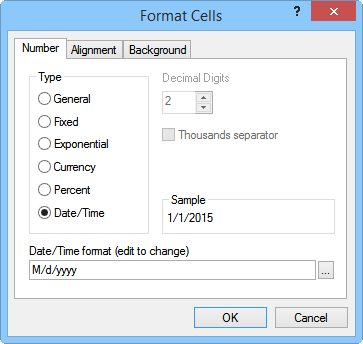Format Cells - Number
Cell numbers, alignment, or background color can be formatted through the Format Cells dialog. To format a cell, select the cells to be formatted, then select Data | Format | Format Cells. Use the Number page to change the numeric data display in the worksheet. This includes setting the numeric format for numbers and the date/time entries.
Number formatting has no effect on a numeric text string (numbers entered as text). For example, an ASCII data file might contain the numbers '8123 (numbers preceded by single quote) which are read as text and not as a number. The Data | Data | Text to Number command can be used to convert numbers stored as text to numeric values.

Use the Number page to change the numeric
data display in the worksheet.
Type
The Type section contains the numeric format for the selected cells. Available options are General, Fixed, Exponential, Currency, Percent, and Date/Time.
-
General displays numbers as fixed or exponential, whichever is shorter.
-
Fixed displays numbers as d.ddd. The number to the left of the decimal can vary. Set the number to the right of the decimal in the Decimal Digits box.
-
Exponential displays numbers as d.ddde+dd. Set the number of digits to the right of the decimal in the Decimal Digits box.
-
Currency displays fixed numbers with a currency symbol such as the dollar sign ($).
-
Percent displays numeric values (such as 0.13) as percentages with a percent symbol suffix (13%).
-
Date/Time formats the cells as dates and/or time. Select Date/Time and then either type the desired Date/Time format or click the
 button to create the desired date/time format in the Date/Time
Format Builder dialog.
button to create the desired date/time format in the Date/Time
Format Builder dialog.
Decimal Digits
The Decimal Digits controls the number of digits to the right of the decimal when the Type is set to Fixed, Exponential, Currency, or Percent.
Thousands Separator
The Thousands separator option controls whether a comma appears in the number, indicating thousands. When checked, a comma appears every three digits to the left of the decimal point. When unchecked, the number appears without the comma. Do not type a comma when entering data as this causes the number to be read as text.
If the Options dialog Decimal separator is set to Comma, or System default when comma is the system default, a period (.) will be displayed for the Thousands separator.
Sample
The Sample box displays the current number format.
OK or Cancel
Click OK to make the change to the cell format. Click Cancel to return to the worksheet without making the change.